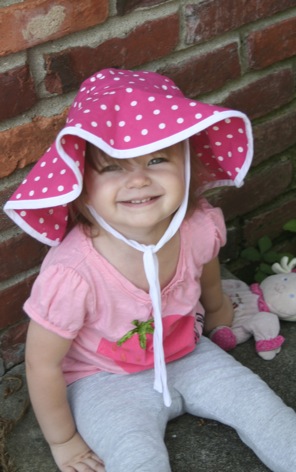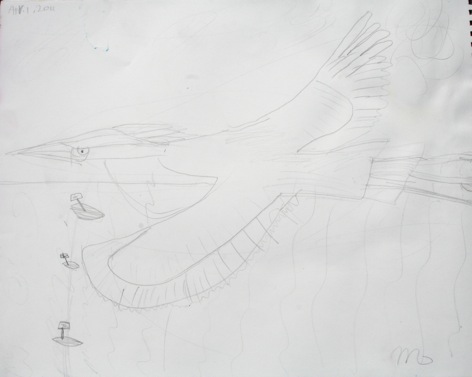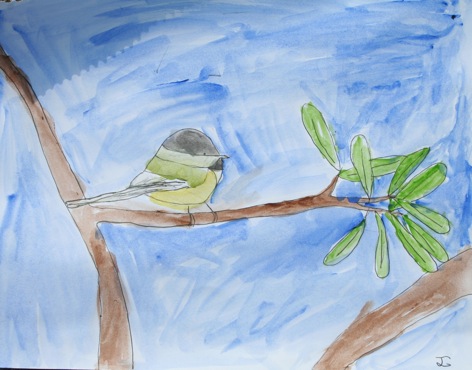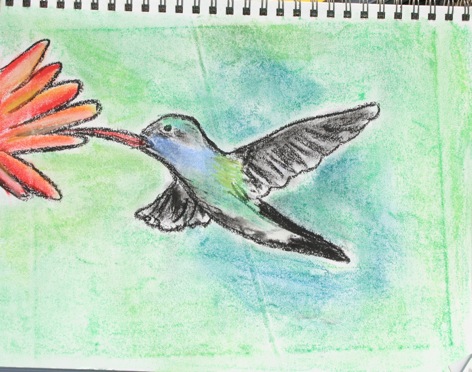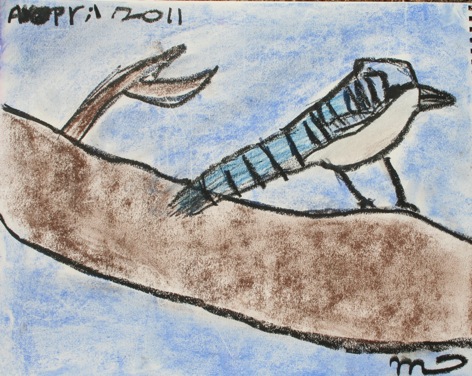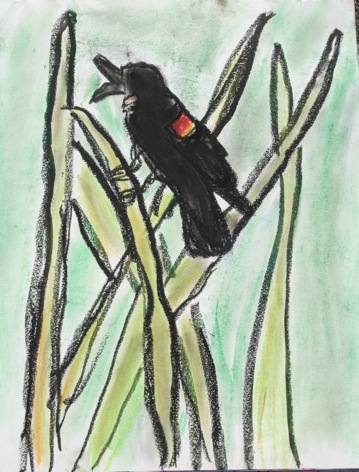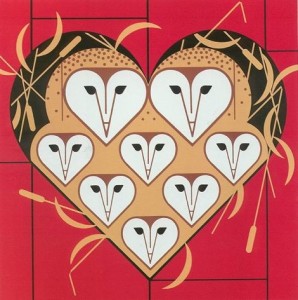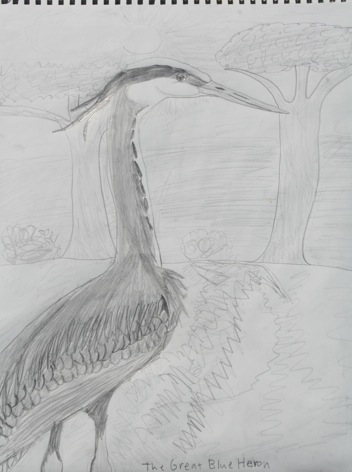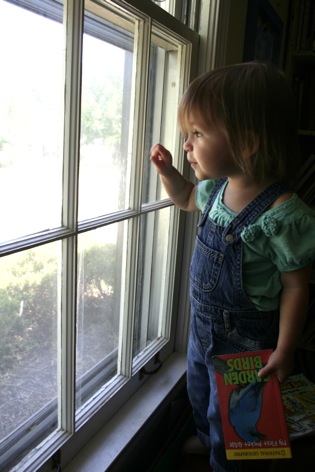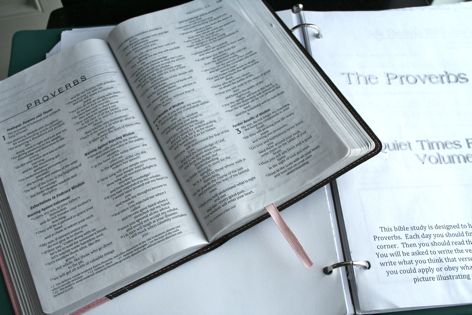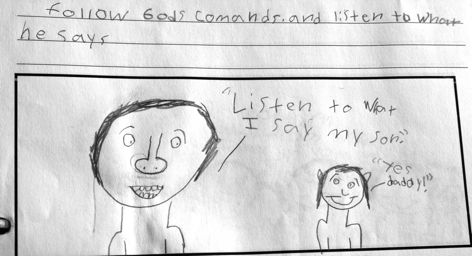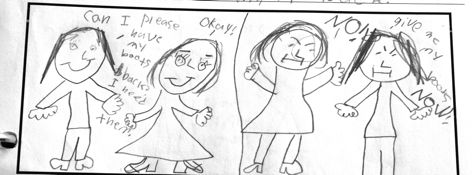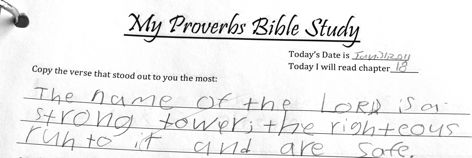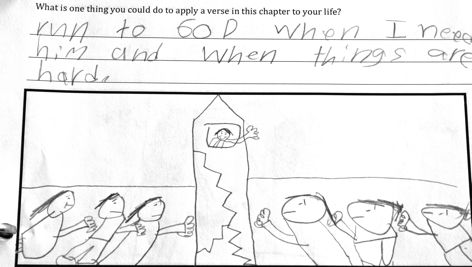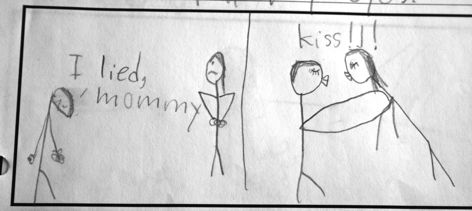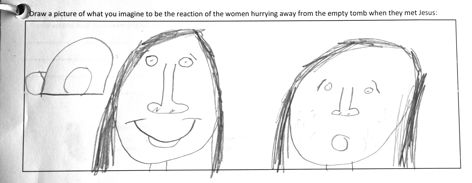Summertime Mama
“Do you school all year round or just the normal school year?”
I pondered this question in those first few years and a older friend said something that’s always stuck and always led me to choose a true summer break.
“My kids have me as teacher mom all through the school year,” she said, “I’m always assigning tasks, telling them something they need to do. Â During the summer, they need me to just be Mom.”
Her simple explanation continues to resonate.
There was the spring that we had taken many breaks because of a medical issue with my Dad. Â I felt pressed to “finish” school, to work long into June, to keep going with Math through the summer. Â After several weeks of schooling in June, I realized we needed to stop. Â I needed to stop. Â And not look back at the books until August.
This morning, our second day of summer break, the 3 older kids played Monopoly until the toddler and I showed up for breakfast(around 9). Â I read aloud during breakfast, they ran off to do their morning chores, and then I surprised them by putting on a video. Â (Only a homeschool family watches Winged Migration, a documentary, for fun, but we did and the two year old acted out the flight patterns of birds. )
My 8 year old made a wise crack during the movie and couldn’t stop laughing at herself. Â I watched her, my eyes lingered on her, without thinking of what task I needed to remind her of, and I smiled. Â We then watched the two year old do acrobatics on the living room chair, and I didn’t have to think once about sending her off with an older sibling so I could do math with the 6 year old.
After a leisurely lunch they headed off to play their marathon monopoly game. Â As I sat here to begin this blog, I realized that the 3 siblings hadn’t fought once during the game over the last few days. Â My dark mom side told me that they would fight soon enough, after the luxury of less schedule turned into bored picking and fighting. Â And then I stopped myself from predicting doom and I remembered my daughter’s laughter from earlier and I thought,
Let’s just take it day by day.
My children need me to have less outside goals and desire just to be with them and delight in them.
So what about math and reading? Â We have a creative way to incorporate reading into our summer and some math games we’ll play so those multiplication and adding skills don’t get lost in the backyard pool(though monopoly seems to be doing the trick right now!).
What about you? Â Do you school in the summer? Â Do you have any secrets for spending time with your children during the school year without always having an agenda or reminder?
Time to Review the School Year-Just Ask Your Kids
We have three official days of school left before the teacher hat goes on the rack for a while and the mom hat leads the way into summer.  Of course I’m thinking about the successes and not-so-successes of the year and making notes for our next year, because that’s just how a homeschool mom-brain works.  In the midst of my mental review, I came across Jimmie’s post with a list of great questions with which to ply the kids and found exactly what they thought about our learning this year, and what they’re most eager to take on next fall(eager is a strong word, they are eager to go swimming, but they are interested in a few studies after their summer break).
So what did I learn from their questionnaires? (I decided to give the questions in a written format, I knew they would like the feel of their opinions as “official” in print.)
A few things were confirmed:
The 10 year old doesn’t like math or cursive. Â The eight year old loves both.
That’s been the pattern for years now. Â It’s not a surprise that they wrote it down in black and white.
History and Art have been a favorite for the whole family this year.
My feelings about history have undergone a radical transformation. Â I’m sure it’s partially that and the fact that we filled our home with great stories with the help of Truthquest that led both girls to include history under “What should we spend more time studying?”.
Nature has become a new interest(the study of, not just the act of being in it) for all of us. Â Both girls asked for more nature study.
I’ve already been writing down ideas for nature study units next year, after our wonderful time studying birds this spring, and it’s so encouraging to read their answers and know that I won’t be pulling them into nature study, they’ll be running right along with me.
Both girls really enjoy doing projects and field trips.
After five years of homeschooling(I guess that’s six if I include preschool for my oldest), we’ve run the gamut of hands-on everything, pre-packaged curriculum, unit studies, and trying out Apologia textbooks. Â I’ve realized that even though I learn best through hands-on activities(and therefore have used hands on as our main learning technique until this year), our history has thrived predominately through reading great books. Â I might have been tempted to take that new freedom(of not doing a lot projects) into next year and miss the fact that the girls still enjoy games and field trips and “doing it” as the 8 year-old so rightly put it. Â I need to carry a balance of both into our studies next year.
What surprised me?
Under “What like skills would you like to learn?”, both girls mentioned “using money wisely”. Â And the 8 year old mentioned grammar(in her defense I did not explain the term life skills before she started answering.) Â But I didn’t know anyone in the family was actually ASKING to learn grammar or learn money skills. Â Which has brought me around to thinking about life skills this summer and next school year. Â Cooking, which I have backed off on letting them help in the last year or two in order to bring peace in that 5pm hour. Â Sewing, can I bring my mom up for a week during the school year for “sewing school”?Money-ooh, I need to work on MY money skills. Â I think a lot about character and spiritual learning, and I’m glad when our academic learning can take a step forward, but thank to Jimmie’s question, I’ll be making a list of life skills as well.
What’s not going to change despite this window into their thoughts?
When asked, “What do you think we should spend less time studying?”, the 10 year old replied, “Math and cursive.”
We have a teriffic math program, math is just a tough subject for her and made even tougher by learning with a younger sister that’s quicker with numbers. Â We’ll march on. Â Cursive is a lovely skill even if miniature keyboards are taking over the world. Both will stay.
So go ask your children some questions. Â You might be surprised, encouraged, and get in a nudge in the right direction for your post swimming pool studies.
Capture the Heart, and the Grammar Will Follow
We’re wrapping up our bird study this week with a final saturation. Â Today we took a couple of online quizzes to test our bird idenitification skills. Â With elbows and pats on the back we spotted bird after bird that would have been unrecognizable two months ago.The kids grab their bird books whenever we leave the house without any suggestive comment from me. Â We share a passion with Grandma now that can continue for years past our official learning time. Â Birding is no longer something I’m teaching them, they feel their own sense of ownership and kinship to these diverse, beautiful creatures.
On the other hand, I also looked through the girls individual assignments they’ve been working on to earn their bird nature patch at the local Nature Center. Â Allowing them to be independent, which is a little newer around here, I haven’t been checking over their work at each step.
Today I got the full picture and and I saw detailed information about bird species, habitat, anatomy, eating habits, and migration. Â I also saw partial sentences, lower case letters to start a sentence, sloppy handwriting, misspelled words, and mistakes crossed out instead of erased and re-written. Â The heart of the work was there, the presentation was lacking!
And whose fault is it? Â We haven’t spent much time on all things grammatical. Â It’s on my list for next year. Â Should I now berate myself and erase mentally what we’ve learned through our nature and art study in the recent months. Â The voice in my head begins, “If my child attended fill-in-the-blank school or lived with such-and-such-homeschool family, I’m sure they would get all of their skills at the same time with the same amount of excellence.”
I could run toward worry. Â I certainly have asked myself some questions today as I went over the necessary corrections with the girls(note: they are turning in this work for their badge, this isn’t work heading into the trash, which is why the focus on appearance presented itself).
Or I can breathe.
Wait, my breathing seemed a little too much like breathing during labor.
Let’s try again.
Do they have to learn all of their skills with equal ability in the 3rd and 4th grade?
Wouldn’t I rather have it this way than perfect punctuation without a bit of interest or passion?
I have a feeling if their hearts are captured with learning, the mechanics will follow easily enough when we’re ready.
Birdwatching Part 2: Art
After Christmas I had three ideas running about my head: poetry, art, and birds. Â We’ve enjoyed all three of them together this spring.
You can read more about our bird study and see our list of resources in this post.
Here are the artists we studied and the projects we explored.
John James Audubon
Books
- Audubon’s Birds of America–This is a wonderfully small book filled with Audubon’s Illustrations. It’s about 5×5 and I was lucky to find it at a used bookstore. Â Audubon’s Book of Birds was not originally published in America due to it’s size. Â He painted the birds life size and he wanted the book printed that way as well. Â I haven’t seen the full-sized book yet. Â Check with your library to see if they have a copy.
- The Boy Who Drew Birds by Jacqueline Davies–A beautifully illustrated picture book. Â A great introduction to the artist.
- A Nest For Celeste by Henry Cole: We follow the kind-hearted mouse, Celeste, as she befriends John James Audubon’s assistant. Â She has many adventures with the birds that are captured for Audubon’s drawings and in the surrounding fields. Â As wonderful as the characters are in this book, the black and white detailed sketches really bring the story to life. Â We kept our bird book on hand so that we could look up pictures of the birds as they entered the story. Â A great companion to study the of birds, mice, and/or John James Audubon’s art.
- On the Frontier with Mr. Audubon by Barbara Brenner-I just came across this book at the thrift store this week. Â It’s a fictional diary of Joseph, Audubon’s assistant(who is the same Joseph in A Nest For Celeste mentioned above), and it follows his journey with Audubon from Cincinatti down to New Orleans. Â We’ve enjoyed the chapters we’ve read so far.
- Audubon’s Birds of America Coloring Books(Dover)-This came with a science program we didn’t finish last year. Â I’m not a big coloring book fan so we didn’t use it a lot. Â Your family might really enjoy it though.
Art Projects
I didn’t plan Audubon specific projects, as far as imitating his exact style. Â But we did focus on realistic bird depiction first. Â So we did a lot of sketching from real birds and photographs of birds in our bird guide once the bird flew away.
Red-Bellied Woodpecker in Bird Sketchbook, 8 year old
Black Ink with Watercolor
- Collect some books from your own collection and the library with good-quality, close-up photography of birds.
- Choose a bird to sketch.
- First sketch your bird along with a part of his/her habitat in pencil.
- Trace all lines with a fine sharpie. Â A thicker sharpie will work as well if the details are not too small. We like to have both sizes on hand. (Make sure your pen is a permanent marker so that it does not bleed with the next step).
- Using watercolors, fill-in your picture. Â You can also use watercolor pencils and then smooth out the color with water and brush.
- Black ink outline and watercolor make for a quickly rewarding piece of art.
Black-Capped Chickadee, 8 year old
Goldfinches on Branch, 10 year old-Don’t you just love the repetition of color and pattern?
Oil Pastel Outline with Chalk Pastel Color
This project produces such vibrant colors! Â Chalk pastels can be messy but they work really well in this project so don’t skimp on them and only use oil. Â I went ahead and bought a pastel fixative to prevent further spreading of the chalk, I’ve read that you can use hair spray as well.
- Collect your books with great bird photography. Â You can also do a google image search and find photographs if you don’t have books on hand.
- Sketch the outline of your bird and habitat with a black oil pastel. Â That’s right skip the pencil. Â Go boldly with your pastel. Â (If your child is frustrated that she can’t erase and fix something in her outline, you can decide if she can switch to pencil. Â You might give her the chance first to transform her oops into something she likes.)
- Fill in your bird, habitat, and background with chalk pastels.
- Trace all lines again with the black oil pastel.
Hummingbird, Mama
Bluejay, 10 year old
Red-winged Blackbird, 8 year old
Charley Harper
I found this artist by accident while looking through the clearance at Barnes and Noble. Â I found a coloring calender and fell in love with his work. Â Like I mentioned, I’m not a coloring book fan, but I had to bring the calender home. Â Harper is a great contrast to Audubon. Â He calls his work minimal realism. “I don’t try to put everything in-I try to leave everything out. Wildlife art without the fuss and feathers.”
His titles include a play on words followed by a tongue and cheek description of the subject. “Beguiled By the Wild” includes an interview that I read aloud to the kids. Â He speaks of how he first learned to draw realistically down to the very hair and how everyone should learn to draw that way first before taking things out. Â A good principle to reinforce with the kids.
- Beguiled by the Wild: The Art of Charley Harper
- Charles Harper Birds and Words
- Charley Harper Coloring Calender-This is the calender I found on clearance. Â The kids colored some of them with colored pencils as they looked at the actual print in order to study his use of shapes and colors before we tried our own.
Charley Harper-Ish Art
Today we tried a Charley Harper Inspired Art Project-I decided to try collage with shapes in order to preserve the defined lines present in his work. Â I’d also like to try a printing project, I haven’t decided how yet.
- I cut out basic shapes(I flipped through his prints to see what shapes he used most often) from cardstock. Â Different sized circles, thin crescents, triangles, teardrops, and leaf shapes.
- I told the kids to pick their bird and the color of their background. Â Using acrylic paint we painted our background.
- Then they looked at photographs of their bird and decided what shapes they needed. Â (We didn’t look at Charley Harper’s version of their bird, I wanted them to decide on their shapes based the actual bird, just like Harper.)
- They used the pre-cut templates and traced them onto various papers.  I have a lot of scrapbook papers collected, you could use construction paper or cardstock. I encouraged them to cut a new shape if they needed it for their bird but  if it wasn’t already cut for them.
- They pasted their bird to the dry background. Â One child took a ruler and added lines to the wings in the style of Harper.
- Finally, if your child is old enough they can try their hand at creating a clever title and/or paragragh.
Barn Owl, 6 year old (He chose the shapes from the template, I helped him trace and cut them, he painted and glued)
“Sky Dive-Not from a plane and not with a parachute and especially not for fun. This falcon is diving for his lunch!”
Age 8
The King Who Fished with His Crown On, Age 10
(Kingfisher)
Part 3 of my Birdwatching posts will be on poetry.
Where Have We Been?-Birdwatching! (Part 1)
Where have we been these last few months? Taking a nice long break from blogs(mine and others) and…
We’ve been watching birds.
Birdwatching falls into the same category as History in my book. Â It’s filed right under Something I Never Thought I Would Care About EVER, But Now I LOVE it. Â This goes right back to my great secret about homeschooling, I have learned to love to learn.
In the same way we’ve become that family that watches historical documentaries for fun, we’re now the odd family trying to identify the birds that somehow made it into the rafters of Home Depot. Â We’re that family-all the way down to the two year old. Â We found her the other morning with the bird guides surrounding her, looking out the front window, identifying birds. True, she categorized all species as “Robin Bird”, but she does so with all the enthusiasm of a life-long birdwatcher.
I’m not a natural-naturalist. Â Homeschool friends think I am until I tell them the real story. Â Nature study doesn’t come easy for us, and it always looks so darn easy and beautiful on other peoples’ blogs. Â Early on I heard about keeping a nature journal and became quite frustrated when my 5 and 7 year old didn’t become Audubon immediately. Was I failing? Â Until this season of birdwatching, I put nature study on the back shelf.
Now I take a view with a longer lens. Â We’ve grown into History. Â We’re having a great, very natural time, studying birds. Â It’s exciting to think what we’ll be doing by the time the youngest is ten or twelve. Maybe science will be in the same category by then! Â So if you read this blog, and think “Oh my goodness, we have to study birds!”, and it doesn’t work for you-then put on the long lens, and keep doing what you’re doing for now. Â There’s time.
This has been a great multi-age study. Â We’ve read our bird books together, taking our nature walks together with baby on the back, and painted and water-colored our birds sitting around the table(okay, sometimes the baby is in bed for a nap by then).
We used to think we had two birds in our backyard: cardinals and robins. Â Now we know we have brown creepers, mockingbirds, starlings, grackles, chickadees, sparrows, and bluejays. Â We never noticed the constant chorus outside, now we notice it all the time. Â We thought all nests were in a tree and all birds ate seeds. Â Boy, did we have a lot to learn!
Our study of birds has included:
- Reading fiction and non-fiction books in the morning after breakfast.
- Working on activities from the nature patch program at our local nature center.
- Going on nature walks with our birds guides and identifying birds. Â (On our most exciting walk we found 9 different bird species, including the Pileated Woodpecker. Â Who knew woodpeckers could be 18 inches long?)
- Identifying birds around our backyard.
- Creating bird related art and poetry.
- Studying artists who have used birds as their subject.
Other than reading bird books every morning, I didn’t have a set schedule-we’ve tried to do related activities 1-2 times  a week.
Here’s are some resources that have transformed birds from black and white into brilliant color:
Activities
- Our local nature center is focused on Birds this season for their yearly Jr. Naturalist Program and they have put together a wonderful pamphlet of bird-related activities that can be done at home or during nature walks. Â Even if you don’t live in Tennessee, this would be a good jumping off point for studying birds together. Â It’s also provided individual work for my 8 and 10 year old as I say, “Go pick another nature patch project and get started.” Â You can print the pamphlet here.
Read-Alouds:
Chapter Books
- A Nest For Celeste by Henry Cole: We follow the kind-hearted mouse, Celeste, as she befriends John James Audubon’s assistant. Â She has many adventures with the birds that are captured for Audubon’s drawings and in the surrounding fields. Â As wonderful as the characters are in this book, the black and white detailed sketches really bring the story to life. Â We kept our bird book on hand so that we could look up pictures of the birds as they entered the story. Â A great companion to study of birds, mice, and/or John James Audubon’s art.
- Burgess Book of Birds by Thornton Burgess-Follow Peter Rabbit as he greets his many bird friends who live near the great orchard, and get to know the cheeky Jenny Wren who always knows the real scoop on everyone. Â Told in story form, we still learned a lot about the behavior and nesting of each bird. Â Take this book a chapter at a time. And keep the bird guide nearby to look at actual photographs.(The edition in the amazon link has photograph illustrations, ours has black and white sketches).
- Owls in the Family by Farley Mowat-I have not read this book, I found it at a used sale, perused it, and the kids have enjoyed it.
Picture Books
- The True Story of Stellina Matteo Pericoli
- Albert by Donna Jo Napoli
- Owl Babies by Marin Waddell
- Owl Moon by Jane Yolen
- Hawk Hill by Suzie Gilbert
Bird Guides
- The Young Birder’s Guide to Birds of Eastern North America(Peterson Field Guide)-Our favorite guide. A great guide for young, new birdwatchers. Â Using photographs instead of artist renderings, it’s easier to match the bird in nature to the bird in the book. Â At a quick glance you can read a physical description and description of the bird call, see what area in North America the bird lives(in all seasons), and it includes photos of both the male and female.
- Tennessee Birds-An introduction to Familiar Species(Pocket Naturalist)-Available for many states, this is a folded guide, good for a quick glance to identify the species and then look it up in a more detailed bird guide. Â This contains pictures and names, with colored illustrations, but no detailed information.
- Beginning Birdwatcher’s Book with 48 stickers(Dover)-I recently purchased this book for our 6 year old since he’s not as adept at sketching birds quickly during a hike. Â As the young birder sees a bird in nature, they find the sticker that matches and place it on the right page. Â Under the box for the sticker is information on food, nesting, range, and eggs, and a place for observations. Â Since buying this book, we’ve only had a chance to use it once. It has a very nice layout. Â I expected, however, a smaller book, easier for placing in a backpack, but this is closer to 12×10. Â I’m also not sure if I like the sticker vs. the sketching format, we’ll have to play with it some more.
- Birds, Nests, And Eggs-A Take Along Guide by Mel Boring: Includes helpful renderings of each bird’s nest and their eggs. Â Also several bird related activities.
Non-fiction Books About Birds
(Note: I just went to the library and grabbed the most interesting books each week. Â These are all great, but you can find other greats just by visiting your library shelf, if these are unavailable.)
- Birds in Your Backyard by Barbara Herkert
- On the Wing: American Birds in Migration by Carol Lerner
- Cradles in the Trees The Story of Birds Nests by Patricia Brennan Demuth
- A Place for Birds by Melissa Stewart
- Birds Build Nests by Yvonne Winer
- Urban Roosts: Where Birds Roost in the City by Barbara Bash
- Perching Birds of North America by Sarah Swan Miller
- Watching Water Birds by Jim Arnosky
- The Robin Makes a Laughing Sound: A Birder’s Journal by Sallie Wolf
- Gone Again Ptarmigan by Jonathon London
- Feathers by  Dorothy Hinshaw Patent
- Owls Whooo are they? by Kila Jarvis and Denver W Holt
Videos about Bird Identification/and other great information about birds
- Cornell School of Ornithology–We have really enjoyed the four videos on this side about bird identification. Â I recommend loading the videos while you’re busy doing something else and then coming back to watch it.
- Planet Earth: Â Don’t miss this breath-taking series. Â Though not specifically about birds, there are bird species throughout. Â Although the narrator includes some evolutionary commentary, we simply spoke to our kids about it first. Without intending to, the producers created a series that brings glory to God and all of His creation!
- March of the Penguins
After you’ve studied birds for a little while, test your knowledge with these two online quizzes.
In the next post I’ll share more about the artists we studied and a few art project and poetry ideas.
Book Review: Bud, Not Buddy

A Book Review by Mookie, age 10
Bud Not Buddy, by Christopher P. Curtis, takes place in Flint, Michigan. Bud, the main character, is an African American boy who is only ten years old but still has lots of adventures. I thought the author did a wonderful job of writing this book.
Bud’s mom has died and his father is gone but his mom left him one clue about his dad. The clue is a blue flyer with a famous music band on the front. When Bud is sent to a foster home he is certain that to find his Dad he must escape, but it’s hard because his foster parents are really mean to him. When he does escape he must go to the city of Grand Rapids, so he tries to jump on a train but it goes too fast and he misses it.  When he finds another way to Grand Rapids, he meets Herman E. Calloway, the famous band player from his blue flyer. Bud thinks Herman is his dad so he’s really surprised when Herman turns out to be his grandfather. Finally, Bud has a family.
The way the author described the characters made them seem real. Everybody says that Bud is skinny, but Bud always answers, “I’m not skinny, I’m just wiry.” I felt like I knew Bud more because Bud had written his own book, and he quotes from it.
“Rules and Things Number 327: When you make up your mind to do something, hurry up and do it, if you wait, you might talk yourself out of what you wanted in the first place.”
I was excited about what would happen next because Bud went on so many adventures, like the time his foster parents locked him in the shed and he got attacked by hornets and had to break the window to get out. I don’t think the author did a good job describing the setting because when Bud is in the city, I had to imagine everything about it. He doesn’t give any descriptions about the places or the landscape. This book was inspiring to me because I’m as old as Bud is in the book, so I feel like I can survive all of the adventures that he did.  Bud, Not, Buddy is a book I would love to read again.
Mookie wrote this book report with the help of this ebook. Â It was her first attempt at a book report (or non-fiction writing in general), and she worked on it independently until the last stage of revision. Â She loved this book and wanted to share her review!
Evan Moor Fairy Tale and Folktale Pockets: A Review
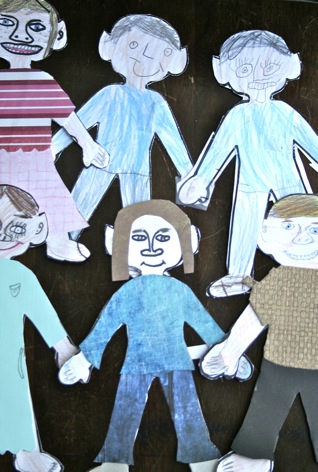
Why I Chose the Evan Moor Folktale and Fairytale Pockets, Grades 2 and 3
With two middle elementary students in the house, I wanted to make sure that we didn’t forget to do some fun, younger activities for our kindergartener. He’s always tagging along with our school time, a little ahead of himself, and I wanted to dip back into the precious early years of learning. I also wanted to try matching him with his 8 year old sister for a project, and give our eldest a independent project.
We really enjoyed the Evan Moor Native American Pockets last year, and I’ve had my eye on the Folktale and Fairy Tale Pockets for a while. Â We started them just after the New Year, as something different to spice up our learning time during the winter slump.
They have indeed spiced things up, and provided the magic that fairy tales bring, something I don’t ever want to lose in our home. Â Our ten year old did her own project and then begged to sit down with us every day because she couldn’t stand to miss the fun. We let her, of course. Â If you’re homeschooling multiple children, these pockets are quite a find, a nice break from balancing multiple projects with many children. Â It’s easy to simplify for younger children and add in more challenging connections for your olders.
You can read more about what’s included in the pockets here. Â I enjoyed the e-book, knowing that I could print just the right amount of copies for our family.
What We Liked
The selection of fairy tales included a handful of favorites and a handful of surprises. Â Each story includes suggestions for extending the lessons and several hands on activities. Â We enjoyed making finger puppets, a story mobile, paper doll elves, painting, and more.
What Needed Adjustment
As was true with our last Evan Moor Pockets, we needed library books to supplement each slim two page fairy tale that was included. Â I also would have enjoyed more background information for my own preparation, such historical information on the folktales and fairytales along with a comparison of the two genres.
Because the focus of the activities involves a lot of cutting and coloring, we can only do these pockets once or twice a year. Â My kids are not big on coloring, preferring to sketch and fill in their own designs. But for some reason, coloring becomes all the rage when we keep these types of activities rare. Â If you’re doing these pockets with just one student, you might think about coloring along with your child or allowing him the choice of coloring or not. Â Remember, coloring a picture in the lines is really an overrated skill! Â You could also move beyond crayons and markers and try watercolors, acrylics, or pastels.
How We Organized the Pockets
As much as we loved the Native American Pockets, our hard work ended with a bulky, oversized, unstable product. Â This time we made the pockets the right size for a three ring binder. Smaller projects were stored in the pocket, larger items(such as the printed fairy tale) were hole punched and added after the pocket.
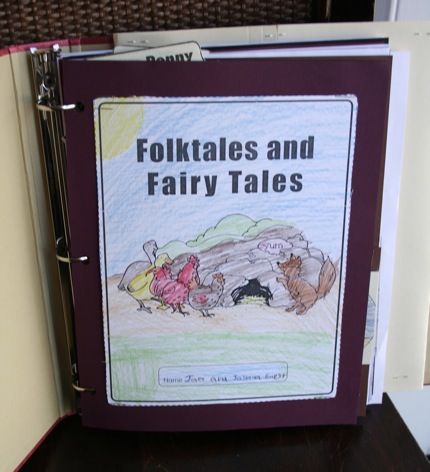
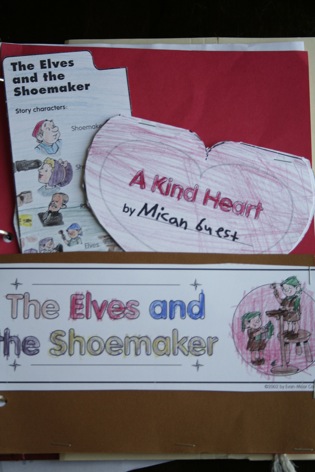
Suggestions for Extended Activities:
- Write your own fairy tale.
- Write a new ending to an already written tale.
- Write a fairy tale from the perspective of a different character (the frog or the witch instead of the Princess, for example).
- Ask an older child to adapt a fairy tale into a play for younger siblings.
- Read a biography about The Grimm Brothers.
Here are some pictures from our learning time.
The Brave Little Tailor

The Fisherman and His Wife
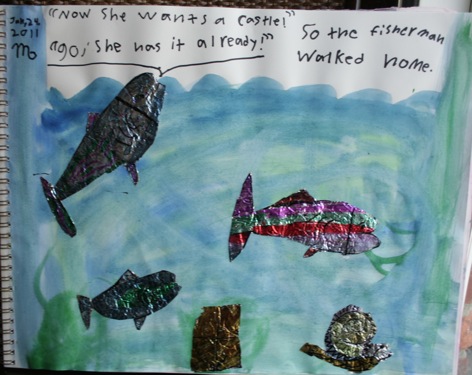
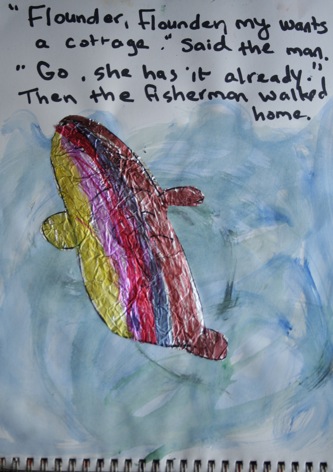
This was an art project inspired here, not an Evan Moor activity.
Jack and the Beanstalk
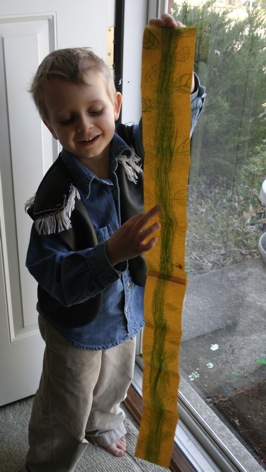
Measuring the beanstalk, an activity from the pockets.
The Elves and the Shoemaker
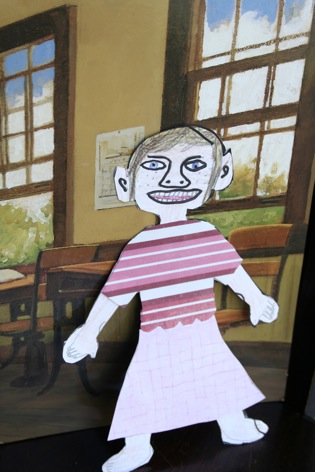
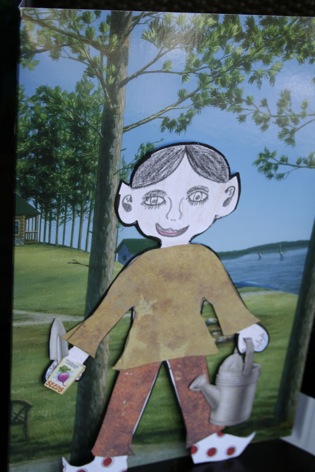
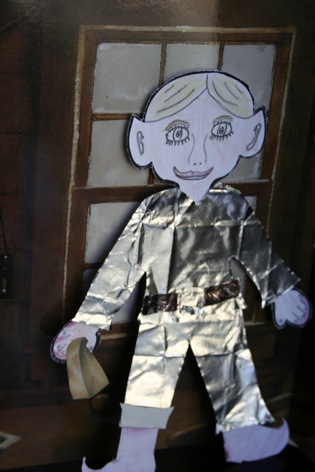
The template for these elves is included, the background is courtesy of the American Girl Molly Paper Dolls.
The Frog Prince
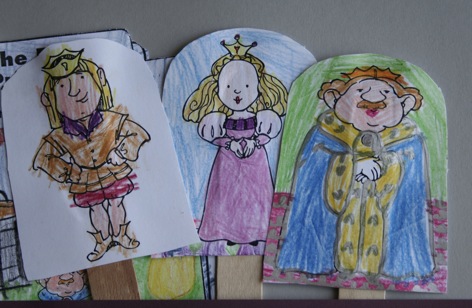
The Bremen Town Musicians
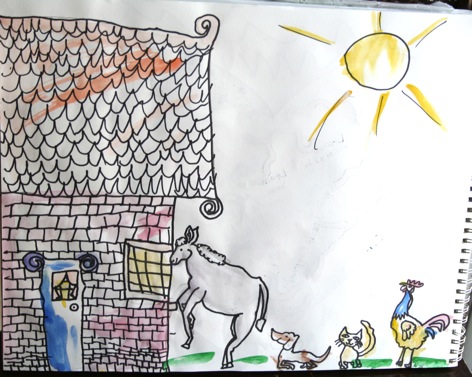
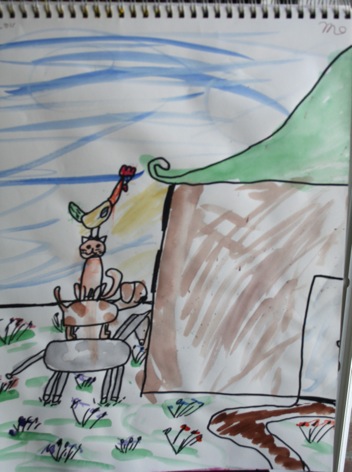
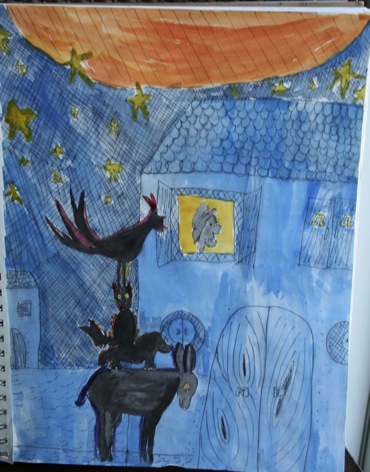
This painting activity is inspired by a project in the pockets, but we based our illustrations on the style of Hans Fischer, shown below.
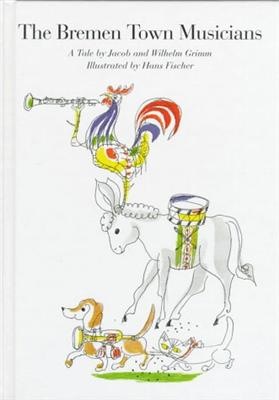
Book and Video Suggestions:
Henny Penny
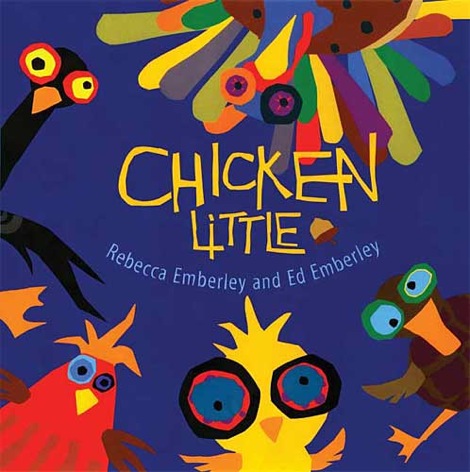
- Henny Penny by Jane Wattenberg
- Chicken Little by Ed and Rebecca Emberley
- Chicken Little on this Scholastic DVD Edition
The Brave Little Tailor
- The Brave Little Seamstress by Mary Pope Osborne
The Fisherman and His Wife
- The Fisherman and His Wife by Rachel Isadora
- Shadow Puppet Version on this Scholastic Video
The Elves and the Shoemaker
- The Elves and the Shoemaker on this Scholastic Video Collection
The Frog Prince
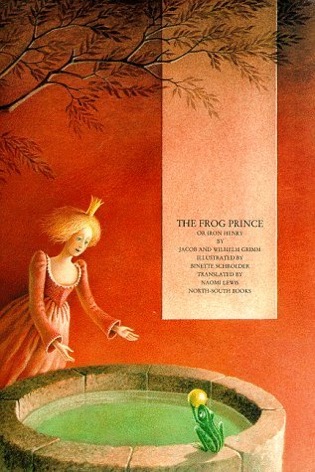
- The Frog Prince or Iron Henry by Jacob and Wilhelm Grimm, Illustrated by Binette Schroeder
- The Frog Prince Continued by Jon Sczeika
The Bremen Town Musicians

The Bremen Town Musicians by Hans Fischer
Other Fun Read-Alouds or Older Child
- The Magician’s Boy by Susan Cooper
- The Sister’s Grimm: The Fairy Tale Detectives by Michael Buckley *
Videos
*Parents may want to preview this selection.
** The musical is a really fun twist on fairy tales and a nice way to wrap up your fairy tale pockets. Â However, you’ll want to preview this video and decide if it’s right for your family. Â We chose to watch only the first act (which is as long as a regular kids movie) as we liked the content of the second half less. Â And we didn’t like the scene with the wolf (it will be rather obvious why), so we just skipped that scene.
My Best Kept Secret
Here’s my best kept secret about homeschooling. Â Are you ready? Okay, I may have shared it before, maybe it’s not even a secret anymore? I could go scrolling back though posts, but it’s much more fun this way.
Lean in close, I’ll whisper it just between you and me.
I’m always learning something new. Â Sure I’m the teacher, but I don’t know most of what I’ve taught from my education. I’ve absorbed it as we’ve gone along and best of all, Â I’ve learned to love learning.
Did that seem like a worthy secret? Â It almost feels like a guilty pleasure to enjoy learning about the world, art, math, history in way I never experienced when I was the student.
What are my qualifications for teaching?
I was a very average student who struggled with math and science, connected history to the bubbles on the multiple choice test, and don’t even get me started on geography. Â B-O-R-I-N-G. Â Somewhere along the middle school years, learning new things began to intimidate me. Â Convinced I probably wouldn’t get it, whatever the lesson of the day, I stopped applying myself to academic classes. Â Even into adulthood this fear stuck with me. Â I didn’t want to take a chance of looking foolish and I was relieved that my days of learning were behind me, since learning happened in school.
I remember when my mentor first mentioned she was planning to homeschool her family. Â She explained, “I want them to love learning.”
That resonated deep in my insecure heart and I continued her thoughts in my head even though I didn’t even have kids yet, “I want them to learn for reasons more than just getting answers right on a test. Â I want them to know they are artists and not have that taken away. Â I want their learning to spill outside the concrete walls.”
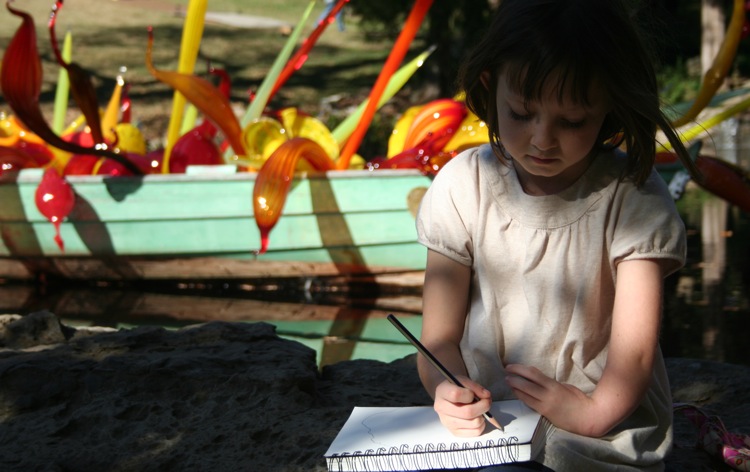
My goals were for my someday-in-the-future kids, but my own fear of learning (and failing), and the related boredom at all subjects outside of literature or the arts wasn’t taken into consideration.
And that’s why this is such a surprise, my own guilty pleasure that I now do math better than I did ten years ago, that the story in history is finally unfolding, and the earth itself is taking on it’s true size and shape.
I saw myself in a neighbor friend that came over  the other day.  My kids wanted to go play explorers in the backyard, a take-off from our months of studying vikings, Columbus, and colonists.
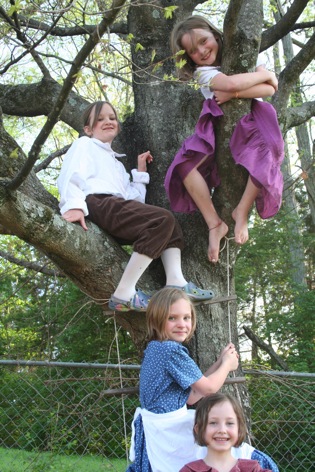
“Oh, we’re studying that in school. Â I always go to sleep and my friend has to keep waking me up, ” our friend replied. Â I saw myself at her age and I looked at my kids and I knew, atleast up to our current studies, that we are well on our way to accomplishing those long ago dreams to instill a love of learning.
I just didn’t know those dreams were for me too.
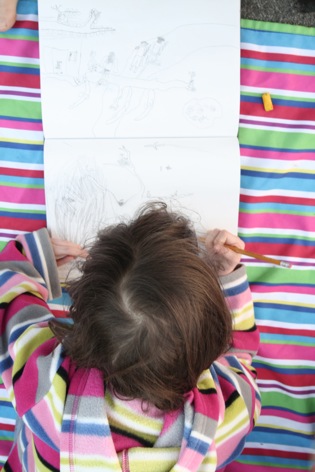
Art Journaling: The Self-Portrait
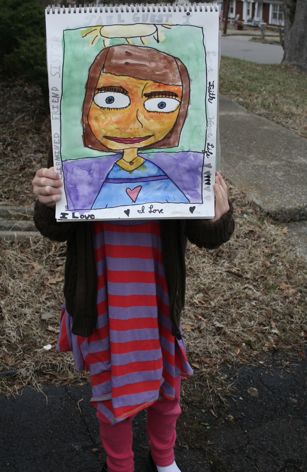
The girls came home with art notebooks from a tutorial that we tried for a few months, notebooks with pages full of different art projects that included watercolor and pastel and suddenly I was taken back to my days of art classes in college when I kept a regular art journal that combined drawing, collage, and writing.
We’ve been using sketchbooks for years here but we’ve always kept the sketching in the book, and the projects outside the book. Not anymore. Â Now we pull out our nice big art notebooks and start dipping into a chosen medium. Â We could do this everyday for three hours if no other school subjects called our names. Â So far we’ve used watercolor, pastels, chalk, sharpie, and collage without any trouble.
This week we’re working with self-portraits.
Project 1: True To Life Self Portrait
On our first day we tried to be as true to the actual image of ourselves as possible. Â I gave them pretty free reign with their mediums because the girls have been doing art forever and they often mix colors better than I can. Â I also suggested they add in words about things they like and who they are into the background.
Mookie, age 10, sat in front of a mirror and came back with lots of insights about the shape of her nose, placement of her nostrils, and relationship of her mouth to her nose. Â This is the best true self portrait she’s done to date. Â She used sharpies and colored pencils. Her words are: Drama, Art, Books, Siblings, Mommy, Daddy, God, God, Jesus, Holy Spirit.
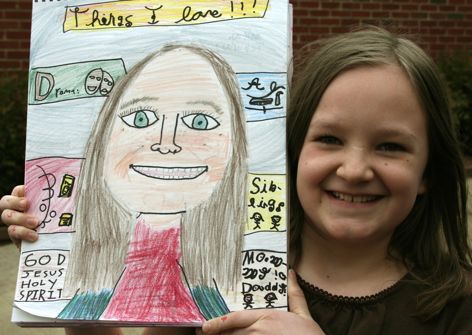
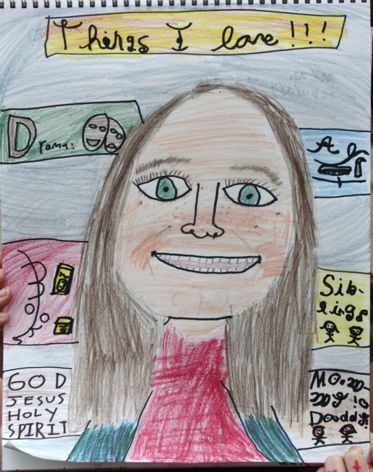
Jellybean, age 8, chose NOT to look in the mirror and she also adapted some exaggerated eyes that she had noticed in the self-portrait in my notebook. Â The larger eyes actually suit her because her eyes are one of the features people notice first about her. Â She used sharpie for outline(they all sketched in pencil first) and watercolor to fill in. Her words are: faith, love, life, hope, sister, determined, friend, I love ART.
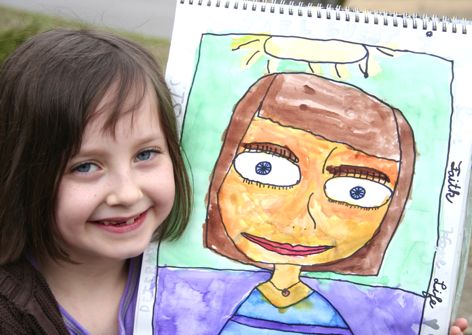

Drummer boy, age 5, had a frustrating time trying to do art with his much more experienced sisters. Â And I forget that he needs a little more guidance than his sisters. Â So he gave up for the day then came back the next day and did a terrific self-portrait, he liked it, and he felt successful. Â He used sharpie and watercolor. Â His words are: big brother, legos, experiments, boy, kiss(he loves kisses).
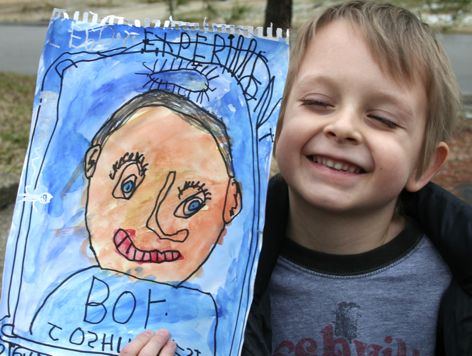
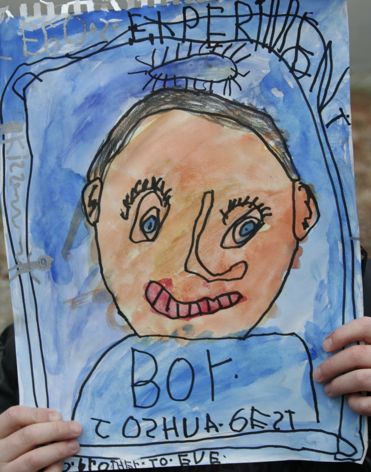
Project 2: Calm/Wild Side Self-Portrait
Today we took our self-portraits to a new place and created portraits with a wild/calm side.
First we looked through picture books on hand and noticed calm and excited/wild colors. For calm we spotted a lot of soothing greens and blue, lighter shades of purple and yellow.  And for excited/wild we noticed oranges, reds, neon greens and bright purples.  We also looked at the pictures for lines in the art.  Straight  and soft curves for calm, and bigger curves, dips, points, and lively patterns for excited/wild.
After drawing a basic head, neck, and shoulder shape, they drew a line down the middle of the page. With pencil they added the details of their wild and calm sides, and then filled in with oil pastels for color.  You can see the original idea for this inspiration here.(This is a great website for art journaling, just scroll down her categories and look for art journaling and you’ll find a wealth of project ideas).
Mookie’s Self-portrait with demonstration of her wild side:
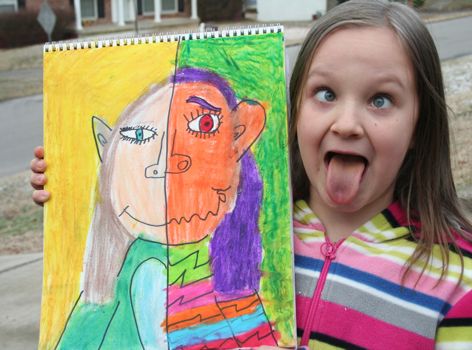
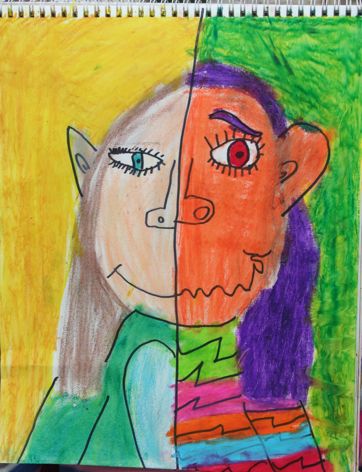
Jellybean:
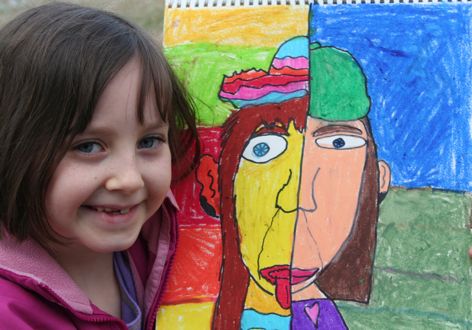
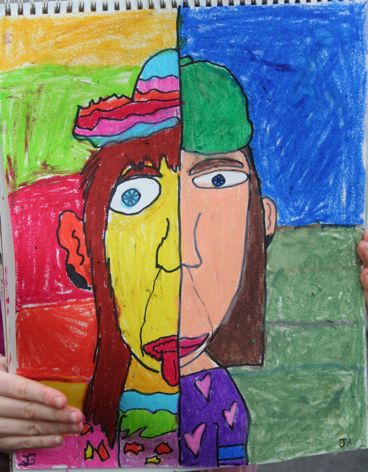
Drummer Boy alternated back in forth between his wild and calm side but he did great with the concept.
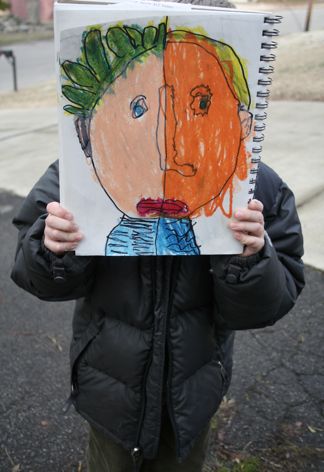
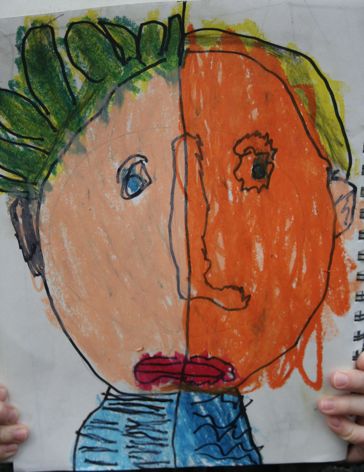
I have plans for a few other styles of self-portraits in the coming weeks and as we ended today’s project Jellbean made a suggestion, “You could decide at the end which of our portraits looks the most like ourselves.” I answered back with my own challenge, “I wonder if it will be the one that looks most true to your actual features or the style that gives the best glimpse into what’s inside your heart. Â We’ll have to see.”

